




An Introduction to Human Bone and the Human Skeleton
Have you ever wondered how our life would have been if we didn't have an exoskeleton made of hard bones? Would we be able to move or stand? Have you seen the picture of a skeleton? Our lives seem to be non-existent without bones. They are the basic building blocks of our posture, balance, and movement. And to think of every single possible action that we do regularly to complete our day-to-day activities, we are dependent on our bones. In this article, we are going to learn what exactly bones are, what they are made up of, how they articulate with each other, and much more.
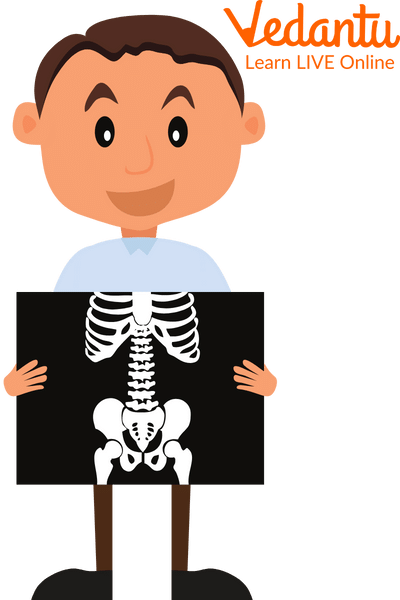
X-ray View of Bones
Human Skeleton System
The human skeleton system consists of 206 human bones in total that make up the backbone of every single human.
At the time of birth, a child is born with 300 human bones consisting of their body. According to researchers the extra bones in a child mature and fuse together to give rise to stronger adult bones.
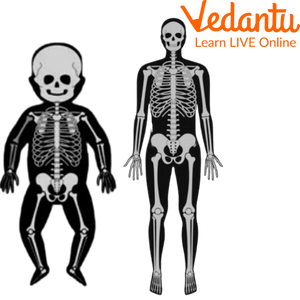
Bones in a Baby and an Adult
The above image shows pictures of the skeleton for both infants and adults. The structure of the human skeletal system is divided mainly into two parts that are the axial and appendicular skeletal systems.
Structure of Skeleton
Axial Skeleton
The axial skeletal system is made up of up to 80 bones namely the skull, vertebral column, sternum, ribs, and ear ossicles (ear bones) that are placed along the primary axis of the body and constitute the axial skeleton. Below are the bones that comprise the axial skeleton:
The skull has two types of bones, namely the facial and the cranial bones. They make up to 22 bones in total.
Cranial bones are 8 in number. They make the outermost protective covering of the brain, called the cranium.
The facial region comprises 14 bones.
A characteristic U-shaped bone named hyoid that does not articulate with any other bone in the body is present in the neck. It supports the tongue.
Each human middle ear has three tiny bones or ossicles namely malleus, incus, and stapes.
The above-stated bones comprise the structure of the human skeleton and the skull.
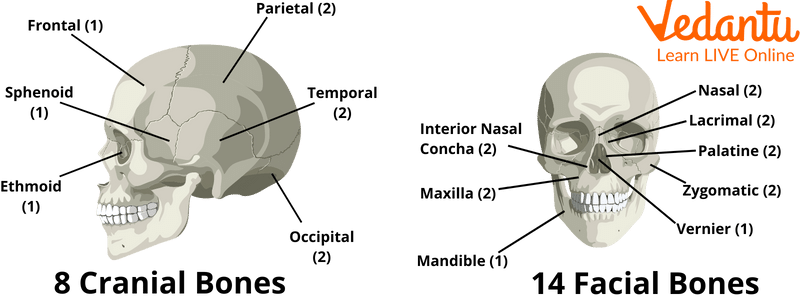
Skull Bones
Vertebral Column
These comprise serially arranged 26 bones or units called vertebrae. The first one of them is called the atlas and helps in the attachment of the skull and the vertebral column. The vertebral column is divided into cervical, thoracic, lumbar, sacral, and coccygeal regions.
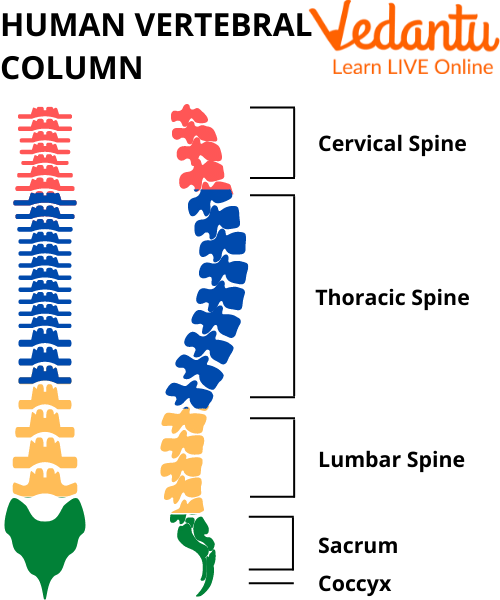
Vertebral Column and its Distinct Regions
Ribs and the Rib Cage
Humans have 12 pairs of ribs in their body that dorsally articulate with the vertebral column and ventrally with the sternum. The first seven pairs of ribs are called true ribs. The 8th, 9th, and 10th ribs are called vertebrochondral ribs or false ribs as they are attached to the sternum through hyaline cartilage. Whereas the remaining two pairs are called floating ribs as they do not connect ventrally with the vertebral column.
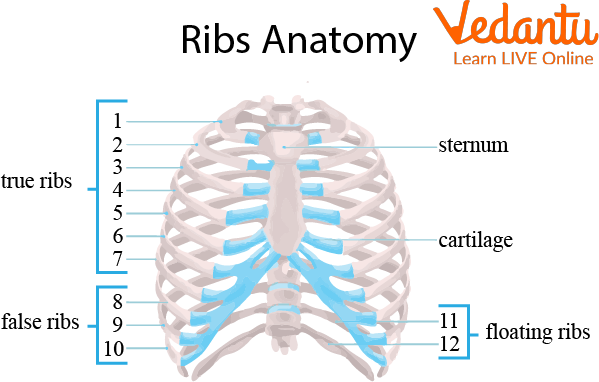
Ribs
Appendicular Skeletal System
This system comprises the bones of the limbs. Each limb has 30 bones which in turn makes 4x30 =120 bones in total. The bones of the hands are called the humerus, radius, ulna, carpals, metacarpals, and phalanges. Whereas the bones of the legs are called the femur, tibia, fibula, tarsals, metatarsals, and phalanges, respectively.
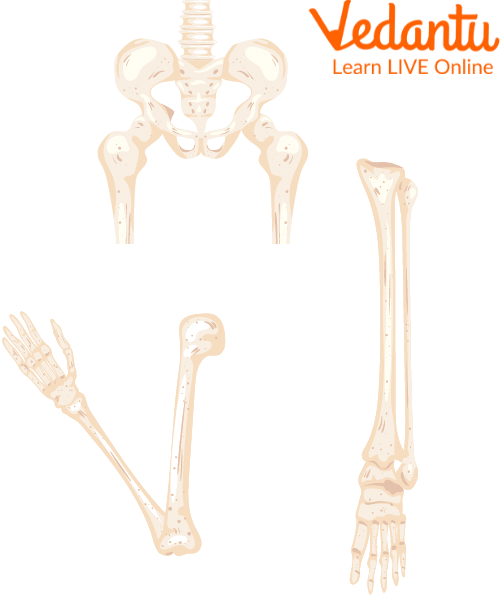
Appendicular Skeleton
Skeletal System Facts
The human skeletal system is unique and here are some of the skeletal system facts.
There is one bone in the body that is not connected to any other bone for functioning, the bone is the hyoid bone.
1% of the world's population has a unique 13-rib system.
Our bones are made of strong calcium salts and designed to take all the wear and tears throughout our lifetime but our teeth are even stronger than our bones.
Various disorders like arthritis and osteoporosis are very common bone diseases that happen due to autoimmune response or old age respectively.
The smallest bones are present in our ears. Stapes are a part of the ear ossicles and are the smallest bone of the human skeleton.
Summary
The human body is framed into a particular framework called the skeletal system and the structural and functional units of the skeletal system are bones. Without a skeletal structure, getting up would require a lot of crawling on the ground. Your body's basic shape is determined by the skeletal system's bones. Your bones would still be formed like a human even if you could remove everything else. Your skull and rib cage are two examples of bones that protect delicate organs. For instance, your skull shields your brain, and the rib cage that houses your heart and lungs keeps them comfortable and secure.
FAQs on Human Bone - Structure of Human Skeletal System
1. What is the scientific study of bones called?
The scientific study of the structure, function, and diseases of bones is called osteology. This field is a sub-discipline of anatomy and anthropology that provides a detailed understanding of the skeletal system's composition and mechanics.
2. How many bones are in an adult human skeleton, and what are its main divisions?
An adult human skeleton consists of 206 bones. It is organised into two principal divisions:
The axial skeleton, which includes the skull, vertebral column (spine), ribs, and sternum (breastbone). It forms the central axis of the body.
The appendicular skeleton, which comprises the bones of the upper and lower limbs (arms and legs) as well as the shoulder and pelvic girdles that connect them to the axial skeleton.
3. What are the main types of bones found in the human body?
Bones are classified into five main types based on their shape and function:
Long Bones: Longer than they are wide, they act as levers for movement (e.g., the femur in the thigh).
Short Bones: Roughly cube-shaped, they provide stability and support (e.g., the carpals in the wrist).
Flat Bones: Thin and often curved, they serve as protective shields for vital organs (e.g., the sternum and skull bones).
Irregular Bones: Have complex shapes that do not fit into the other categories (e.g., the vertebrae of the spine).
Sesamoid Bones: Small, independent bones embedded within tendons, such as the patella (kneecap).
4. What are the primary functions of the human skeletal system?
The human skeletal system performs several crucial functions beyond providing a basic framework. These include:
Support: It provides a rigid structure that supports the body's weight and shape.
Protection: It shields vital internal organs, like the skull protecting the brain and the rib cage protecting the heart and lungs.
Movement: It serves as an attachment point for muscles, acting as a system of levers to produce motion.
Mineral Storage: Bones are a major reservoir for minerals, especially calcium and phosphorus, which can be released into the blood when needed.
Blood Cell Production: The bone marrow inside certain bones is responsible for producing red blood cells, white blood cells, and platelets.
5. What types of cells are responsible for building and maintaining bones?
Bone tissue is constantly being remodelled by three specialised types of cells:
Osteoblasts: These are the 'bone-building' cells that are responsible for synthesising and mineralising new bone tissue.
Osteoclasts: These cells are responsible for the breakdown and reabsorption of old bone tissue, a process crucial for repair and mineral regulation.
Osteocytes: These are mature bone cells that get trapped within the bone matrix. They help maintain the bone and sense mechanical stress.
6. Why are bones not completely solid inside?
Bones are not solid all the way through to achieve a balance between strength and weight. The outer layer is made of dense compact bone for rigidity and protection. The interior contains spongy (or cancellous) bone, which has a honeycomb-like structure. This design not only makes the skeleton lighter but also provides space for bone marrow and helps to absorb shock and stress from different directions.
7. How are teeth different from bones?
Although they appear similar and both contain calcium, teeth and bones are fundamentally different. The primary difference is their ability to heal. Bones are living, vascular tissues that contain collagen and living cells (osteocytes) which allow them to regenerate and heal after a fracture. In contrast, teeth are primarily composed of enamel, dentin, and pulp. Enamel is the hardest substance in the human body but lacks the regenerative capabilities of bone, meaning damage to teeth is permanent without dental intervention.
8. Why do babies have more bones than adults?
A baby is born with approximately 300 bones, many of which are composed of soft cartilage. As a child grows, a process called ossification occurs where this cartilage hardens into bone. Furthermore, many of these smaller bones fuse together to form larger, single bones. For example, the several bones of the skull fuse into a solid cranium. This fusion process reduces the total count to the 206 bones found in a typical adult skeleton.









